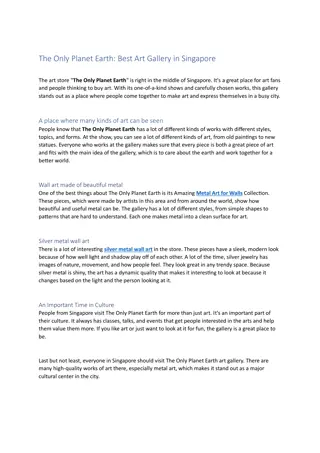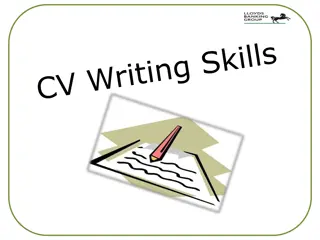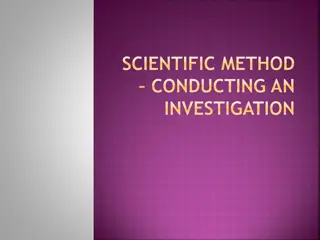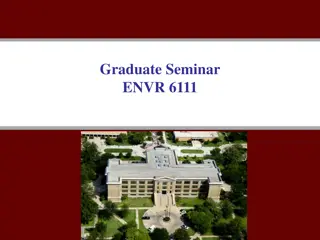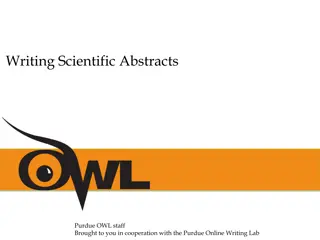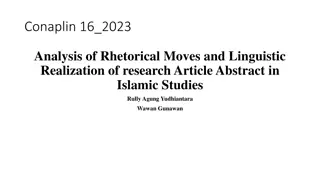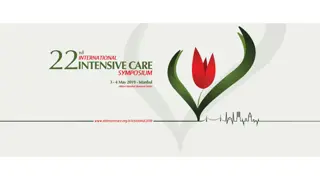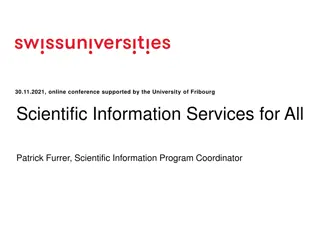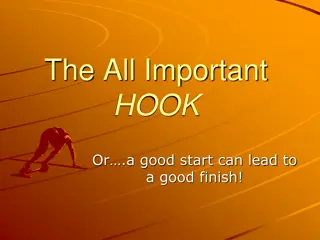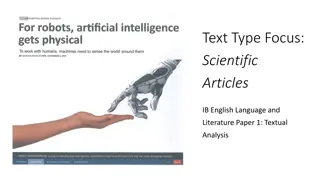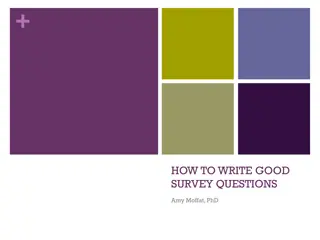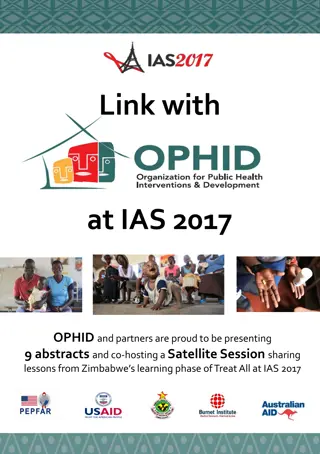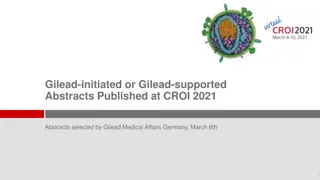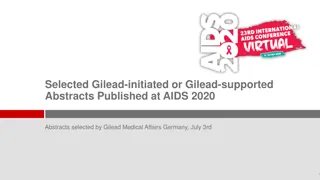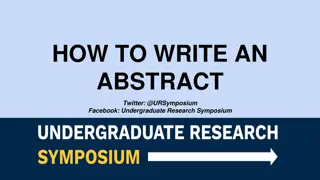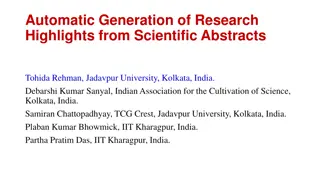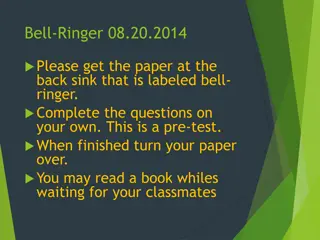Mastering the Art of Crafting Scientific Abstracts
Delve into the world of scientific abstracts with insights from Dr. Gail P. Taylor, exploring the essential components, formats, and processes for successful abstract creation and presentation at conferences.
Download Presentation

Please find below an Image/Link to download the presentation.
The content on the website is provided AS IS for your information and personal use only. It may not be sold, licensed, or shared on other websites without obtaining consent from the author.If you encounter any issues during the download, it is possible that the publisher has removed the file from their server.
You are allowed to download the files provided on this website for personal or commercial use, subject to the condition that they are used lawfully. All files are the property of their respective owners.
The content on the website is provided AS IS for your information and personal use only. It may not be sold, licensed, or shared on other websites without obtaining consent from the author.
E N D
Presentation Transcript
Scientific Abstracts Dr. Gail P. Taylor Associate Director of STEM Initiatives Asst. PD MBRS-RISE Research Training Programs University of Texas at San Antonio Rev 9/2019
Acknowledgements -Abstracts Online How-To Presentation from SACNAS http://www.vimeo.com/3968357 How to construct a Nature summary paragraph http://www.nature.com/nature/authors/gta/Letter_bold_para.doc Sir Conferences Abstract Preparation and how to write a good abstract: http://www.sirmeeting.org/index.cfm?do=cnt.page&pg=1135
Student Conference Submission/Instruction Pages SACNAS https://www.sacnas.org/conference/research-presentations ABRCMS https://abrcms.org/index.php/present-at-abrcms/submit-an-abstract Most conferences put out a Call for Abstracts or Abstract Submission Google 2024 OUR Showcase: https://utsa.az1.qualtrics.com/jfe/form/SV_6YkAZROlHCsHMQm
What is an Abstract? Summary report of research study Single paragraph manuscript Several types In papers Included in grant proposals Conferences Conferences Determines format/style/length Approval required for Presentation Published in books/proceedings or electronically THESE ARE A PUBLICATION FOR YOUR CV!!!! Draws people to your work Some fields have mini-papers
General Abstract Format Introduction: Start Broad and get specific End with Purpose/Hypothesis Methods Make this very superficial Results Include some data Discussion/Implications Funding Source (if not included elsewhere on submission site)
Abstract Process for Conferences CREATE Examine call for abstracts or Presentations rules With research mentor (you may have to press on explicit hypothesis Write abstract (multiple drafts with mentor) Make sure to include grant / number SUBMIT Double check rules Final mentor approval Choose Oral Presentation or Poster (might not have choice) CONFERENCE RESPONSE: Accepted or not Oral or Poster (you usually choose Oral, and drop to poster) REGISTER FOR CONFERENCE CREATE PRESENTATION GO TO CONFERENCE / GIVE PRESENTATION
General Rules... Concise as possible Body length determined ~300 Words (250 for SACNAS and Showcase) ~2500 Characters (Spaces or not???) Title length may be determined Formatting specified Font used and its size Title capitalization Single spaced Third Person Active Tense allowed now (We found..) Usually no references or figures (check with PI) Engineers or other computational fields may include these Usually no references Broadens out arallels Intro ABRCMS Call for Abstracts 2019
Mentor Involvement Research Mentor needs to be involved at all levels Experiments to include Best story from sub-project and available data What they want revealed It s short but may need many drafts back and forth w mentor PIs ****Some will try to take out hypothesis or make abstract too long or technical**** Be ready to show conference rules and examples Need to start early Develop plan/timeline Will they be in town to review or help? NEED FINAL APPROVAL FOR SUBMISSION! Abstract is publication Represents them and their lab They look bad if their student messes up Recheck before using it elsewhere Don t change it after approval!
Authorship Always has more than YOU! Generally: You (first) PI (generally Last) Others who contributed significantly to project In order of extent of contribution Nearer to first author better
Advice on Writing Short but time-consuming Information-dense, but simply formatted Follow Conference Rules! Write long and pare down if needed Analyze one sentence at a time Each sentence has purpose Each sentence is clear and straightforward plain English Split up long sentences (usually only two lines ) Combine very short sentences Each sentence logically follows another Include transition words in sentences Similarly, in addition, concurrently, as a result, further, etc. Remember active 3rd person (we) voice, or passive when needed Make sure to provide take Home message There is not good writing, only good rewriting
Tense in Scientific Writing PRESENT TENSE Previously published information accepted as fact Usually In Intro FGF-2 expression is found in the nailbed Spatial resolution of MR microscopy can reach 3 microns. In Conclusions with Implications of your findings Our findings suggest/we conclude PAST TENSE We Hypothesized Methods and Results/Actions What we did, saw, and found Rats were anesthetized with isoflurane. All animals exhibited significantly diminished learning Duke University Medical Center http://wwwcivm.mc.duke.edu/civmResources/iplHelp/writing.tips/tenses.html
Abstract Title Length and text style may be determined by conference Is your shortest summary of your work Will also be used for your poster Helps people to choose and find article Needs to be concise, specific and active: Omits A study of, Investigations of, etc Spell out most acronyms Put species studied Mention variables/treatment Put limiting information Avoid cute May or may not give results (Mentor s choice) Topic Effects of phenobarbital on learning Conclusive Phenobarbital diminishes learning Ex: Effect of Owner Education Level on Number of Cats per Household Ex: FGF-2 Induces Regeneration of the Chick Limb Bud
Abstract - Introduction Rationale for Study - Motivation Generally max 3 sentences Engages readers Interesting (consider type of conference) No refs (check w mentor) General information to specific. Big problem (Medical condition/Improve world) Findings leading directly to your research (not summary of field) You will flow into the problem (next slide)
Abstract Purpose& Hypothesis Specific problem and what you guessed/expected The purpose of this research was to We hypothesized that Some fields do not have hypothesis Chemist optimizing a reaction Engineer designing something Sometimes hypothesis is implied and not stated If you have hypothesis, state for student conferences (required)
Abstract Methods/Approach How did you solve your problem? Two sentences (or less) are needed for short abstract What experiments did you run using what method(s)? What variables? Often worked into text. Using XXX we did this and found X. Then we used XXX to find XXX. Give general idea No vendor info needed
Abstract - Results What did you find? At most three sentences Include your most important summarized data that influenced your conclusion Include mean values, significance, standard deviations, number of samples you studied, etc.) (In some fields they do NOT do this up to mentor)
Abstract - Discussion ~Three sentences Conclusions What does your work mean? What is the big point/Take Home Message!! (How did hypothesis turn out?) Future Directions
Acknowledgements of Funding At end, MAY place recognition of funding source: NIGMS MBRS-RISE GM060655 NIGMS MARC-U*STAR GM007717 Work Study Research Training Program Your mentor s grant CIMAXXXXX
Submit! With final permission from your PI submit! Can also submit a travel award (they pay for you to go!) Await a Response May get an Oral (if requested) Otherwise, will probably be a Poster
Acceptance! Dear SACNAS Colleague, It is with great pleasure we inform you that your abstract "OPTICAL PROPERTIES OF WHOLE HUMAN BLOOD IN THE NEAR IR REGION" has been accepted for poster presentation at the 2009 SACNAS National Conference - October 15-18, 2009 in Dallas, Texas. If you must cancel your presentation at any time, please contact me immediately, michael@sacnas.org; TollFree 877-722-6271 x333. As the Conference approaches, please look for more emails from SACNAS regarding guidelines for presentations, exact time/date/location of your presentation, as well as information on the many opportunities present at this year's Conference in Dallas. Kind Regards, xxxx








